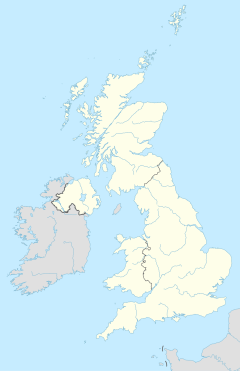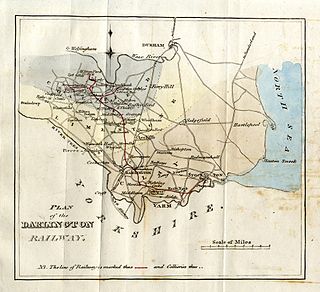
The Stockton and Darlington Railway (S&DR) was a railway company that operated in north-east England from 1825 to 1863. The world's first public railway to use steam locomotives, its first line connected collieries near Shildon with Darlington and Stockton-on-Tees in County Durham, and was officially opened on 27 September 1825. The movement of coal to ships rapidly became a lucrative business, and the line was soon extended to a new port at Middlesbrough. While coal waggons were hauled by steam locomotives from the start, passengers were carried in coaches drawn by horses until carriages hauled by steam locomotives were introduced in 1833.

Middleton St George is a large village and civil parish in the borough of Darlington and the ceremonial county of County Durham, England. It is situated approximately 3.5 miles (5.6 km) east of Darlington. According to the 2011 UK Census the population was 3,779, including Middleton One Row, Low Middleton and Oak Tree. It has grown rapidly since the mid-1990s, becoming a commuter area for Darlington. The population of the Darlington ward in question again taken at the 2011 Census was 4,650.

The Durham Coast Line is an approximately 39.5-mile (63.6 km) railway line running between Newcastle and Middlesbrough in North East England. Heavy rail passenger services, predominantly operated Northern Trains, and some freight services operate over the whole length of the line; it provides an important diversionary route at times when the East Coast Main Line is closed. Light rail services of the Tyne and Wear Metro's Green Line also operate over the same tracks between a junction just south of Sunderland station and Pelaw Junction.

Darlington railway station is on the East Coast Main Line in the United Kingdom, serving the town of Darlington, County Durham. It is 232 miles 50 chains north of London King's Cross and on the main line it is situated between Northallerton to the south and Durham to the north. Its three-letter station code is DAR.

Northallerton railway station is on the East Coast Main Line serving the town of Northallerton in North Yorkshire, England. It is 218 miles 36 chains (351.6 km) north of London King's Cross between Thirsk to the south and Darlington to the north. Its three-letter station code is NTR.

The Tees Valley Line is a rail route, in Northern England, following part of the original Stockton and Darlington Railway route of 1825. The line covers a distance of 38 miles (61 km), and connects Bishop Auckland to Saltburn via Darlington, Middlesbrough and 14 other stations in the Teesdale.

Stockton is a railway station on the Durham Coast Line, which runs between Newcastle and Middlesbrough via Hartlepool. The station, situated 5 miles 45 chains (9.0 km) west of Middlesbrough, serves the market town of Stockton-on-Tees in County Durham, England. It is owned by Network Rail and managed by Northern Trains.

Bishop Auckland is a railway station that serves the market town of Bishop Auckland in County Durham, North East England, 11 miles 77 chains (19.3 km) north-west of Darlington. The station is the Western terminus of the Tees Valley Line, which links it to Saltburn via Darlington. It is owned by Network Rail and managed by Northern Trains.

Dinsdale is a railway station on the Tees Valley Line, which runs between Bishop Auckland and Saltburn via Darlington. The station, situated 3 miles 65 chains (6.1 km) east of Darlington, serves the village of Middleton St George, Darlington in County Durham, England. It is owned by Network Rail and managed by Northern Trains.
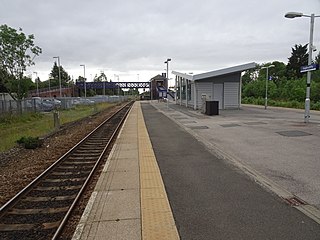
Eaglescliffe is a railway station on the Tees Valley Line, which runs between Bishop Auckland and Saltburn via Darlington. The station, situated 8 miles 63 chains east of Darlington, serves the village of Eaglescliffe, Borough of Stockton-on-Tees in County Durham, England. It is owned by Network Rail and managed by Northern Trains.

The South Durham & Lancashire Union Railway (SD&LUR) built a railway line linking the Stockton & Darlington Railway near Bishop Auckland with the Lancaster and Carlisle Railway at Tebay, via Barnard Castle, Stainmore Summit and Kirkby Stephen. The line opened in 1861 and became known as the Stainmore Line.

Croft Spa railway station was a railway station serving the settlements of Croft-on-Tees and Hurworth-on-Tees in County Durham, England.
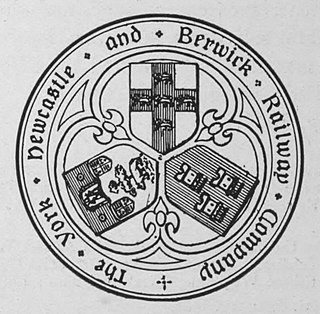
The York, Newcastle and Berwick Railway (YN&BR) was an English railway company formed in 1847 by the amalgamation of the York and Newcastle Railway and the Newcastle and Berwick Railway. Both companies were part of the group of business interests controlled by George Hudson, the so-called Railway King. In collaboration with the York and North Midland Railway and other lines he controlled, he planned that the YN&BR would form the major part of a continuous railway between London and Edinburgh. At this stage the London terminal was Euston Square and the route was through Normanton. This was the genesis of the East Coast Main Line, but much remained to be done before the present-day route was formed, and the London terminus was altered to King's Cross.
West Auckland railway station served the villages of St Helen Auckland and West Auckland in County Durham, England, between 1833 and 1962. It was on the railway line between Bishop Auckland and Barnard Castle. There was a locomotive depot, which was the only one to be both closed completely and later reopened by the London and North Eastern Railway.

Ferryhill was a railway station located in Ferryhill in County Durham, Northeast England. It was located on what became the East Coast Main Line between Darlington and Durham, close to the junctions with several former branches, including the extant freight-only Stillington Line to Norton-on-Tees and Stockton.

The Darlington and Barnard Castle Railway, was an east–west railway line that connected Darlington and Barnard Castle in County Durham, England. Besides the main running line, it had two branches that headed south into Yorkshire that were only used for freight. The whole system opened up by July 1856 and was closed completely by 1966. The former Merrybent freight branch is now used as part of the A1(M) road that bypasses to the west of Darlington.
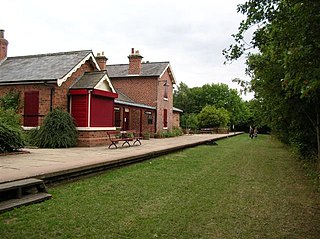
Thorpe Thewles railway station was a railway station on the Castle Eden branch of the North Eastern Railway (NER) from 1880 to 1931. It was located approximately 5 miles north of Stockton and was designed to serve the village of Thorpe Thewles and the civil parish of Grindon in Stockton-on-Tees, part of the Ceremonial County of Durham, North East England but, despite its name, was actually located further from the village of Thorpe Thewles than Carlton station on the main line of the Clarence Railway.
Wynyard railway station was a railway station on the Castle Eden branch of the North Eastern Railway (NER) from 1880 to 1931. It was located immediately to the south of the bridge carrying the Hartlepool to Sedgefield road and served little more than a few scattered hamlets, including Embleton and Swainston. Despite its name, the station was poorly situated for Wynyard Park which was better served by the neighbouring station at Thorpe Thewles.

Hurworth Burn railway station was a railway station on the Castle Eden branch of the North Eastern Railway (NER) from 1880 to 1931. It was located between the embankment carrying the railway over Hurworth Burn Reservoir and the bridge carrying the line over the Hart to Trimdon road. As well as serving the then relatively new reservoir, the station primarily served a few scattered hamlets though it was also the nearest station to the village of Sheraton.

Wellfield railway station was a railway station that served the village of Wingate in County Durham, England. It was built by the North Eastern Railway (NER) on the route of the Hartlepool Dock & Railway (HD&R) to allow interchange between the existing line and their newly opened line from Stockton-on-Tees.



